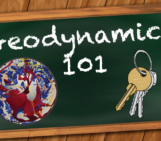
Every week, The Sassy Scientist answers a question on geodynamics, related topics, academic life, the universe or anything in between with a healthy dose of sarcasm. Do you have a question for The Sassy Scientist? Submit your question here or leave a comment below.
In a comment on a post about the key papers in geodynamics, the Curmudgeonly Commenter asked:
Could you please point out some exceptionally important papers in geodynamics and tell us something interesting about the history of the field?
Dear CC,
“Enough with the seismology and rock mechanics”, I hear you scream. You came to this blog for geodynamics! And geodynamics you will get.
There is one key aspect of the earthquake cycle; it should be embedded in a longer time interval than just one earthquake, as fostered recently by e.g., van Dinther et al. (2013a, b). Indeed, how can an earthquake stand alone? Doesn’t the ‘background’ stress field play a major role in loading the faults in a — continuum — lithosphere but especially during the post-seismic ‘relaxation’ period? And what if you’re generating new faults, or changing your continuum material properties over time? Does pore-fluid pressure provide an indication for future earthquakes, or does the presence of water in your fault zone only lead to healing, and eventual long-term locking? Understanding the 3D, geodynamic setting of the region where you expect this earthquake to happen is paramount; the stresses imparted upon a locked fault patch (which can be geometrically complex) due to far-field tectonics may define whether that fault will fail or not.
On the other hand, our understanding of what happens during an earthquake is also … let’s say limited. Yes, we can obtain some slip distribution that shows how much motion was accommodated during an earthquake. This doesn’t provide an inkling of the underlying nucleation process. Dynamic rupture models (e.g., Das 1980; Koller et al. 1992; Tada et al. 2000) can simulate the nucleation of an earthquake on (not just planar) fault planes. This sounds exiting as actual earthquake sources produce seismic waves, and rupture fronts of earthquakes that can even reach super-shear velocities — in a super-shear rupture the rupture front travels faster than the shear wave speed!!! See e.g., Das (2015) for an extensive explanation on this topic. However, and yes there’s always a however, the strength of a fault and the prescribed conditions of failure are limiting factors; are these actually feasible parameters? Besides the rate-and-state of the fault (segments), the stress field may — no — will control the extent, speed and magnitude of the eventual rupture (e.g., Aochi and Fukuyama 2002). So yes, we need geodynamics — sure, a bit of rock mechanics and seismology will do too — but primarily geodynamics to make further steps.
When we consider seismic hazard, should we just focus on the one earthquake lying and waiting in silence, prowling patiently until we have forgotten that it may strike, or be ever so vigilant, obtain every shred of evidence at any scale (both in time and space) of the earthquake cycle and scope every angle to have any hope of cracking the enigma? There’s a lot to be done still. However, not only geodynamicists have pounced on this earthquake problem. Other disciplines smelled societal relevance and funding as well, so that will be the topic of next week.
If you think “but I want to know more about earthquakes and the role of geodynamics in solving this issue” (as well you should), I would like to refer everyone to van Zelst et al. (2019) for an at-length discussion of the inferences of dynamic rupture models that are coupled with geodynamically enforced stress states. What a paper!
Yours truly,
The Sassy Scientist
PS: This post was written under duress by our awe-inspiring Editor-in-Chief to provide some promotion of her recent paper. Some people are just shameless…
References: Aochi, H. and Fukuyama, E. (2002), Three-dimensional nonplanar simulation of the 1992 Landers earthquake.Journal of Geophysical Research: Solid Earth, 107(B2), ESE–4. Das, S. (1980), A numerical method for determination of source time functions for general three-dimensional rupture propagation. Geophysical Journal International, 62(3), 591–604. Das, S. (2015), Supershear Earthquake Ruptures – Theory, Methods, Laboratory Experiments and Fault Superhighways: An Update. In: Perspectives on European Earthquake Engineering and Seismology. Geotechnical, Geological and Earthquake Engineering volume 39, edited by A. Ansal, doi:10.1007/978-3-319-16964-4_1 Koller, M.G., Bonnet, M. and Madariaga, R. (1992), Modeling of dynamical crack propagation using time-domain boundary integral equations, Wave Motion, 16, 339–366 Tada, T., Fukuyama, E. and Madariaga, R. (2000), Non-hypersingular boundary integral equations for 3-D non-planar crack dynamics, Computational Mechanics, 25, 613–626. van Dinther, Y., Gerya, T.V., Dalguer, L.A., Corbi, F., Funiciello, F. and Mai, P.M. (2013b), The seismic cycle at subduction thrusts: 2. Dynamic implications of geodynamic simulations validated with laboratory models. Journal of Geophysical Research: Solid Earth, 118(4), 1502–1525. van Dinther, Y., Gerya, T.V., Dalguer, L.A., Mai, P. M., Morra, G. and Giardini, D. (2013a), The seismic cycle at subduction thrusts: Insights from seismo-thermo-mechanical models. Journal of Geophysical Research: Solid Earth, 118(12), 6183–6202. van Zelst, I., Wollherr, S., Gabriel, A.-A., Madden, E.H. and van Dinther, Y. (2019), A dynamic rupture simulation of a megathrust earthquake constrained by geodynamic and seismic cycle modelling, Journal of Geophysical Research: Solid Earth, accepted manuscript



